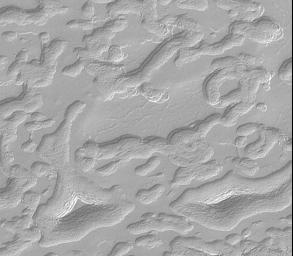
|
South Polar Cap Erosion and Aprons
- Click the image above for a larger view
- Full-Res JPEG (543 x 476) (47.8 kB)
- Full-Res TIFF (543 x 476) (246.7 kB)
Caption:
This scene is illuminated by sunlight from the upper left.
While Mars Global Surveyor (MGS) Mars Orbiter Camera (MOC) images have shown that the north and south polar cap surfaces are very different from each other, one thing that the two have in common is that they both seem to have been eroded. Erosion in the north appears mostly to come in the form of pits from which ice probably sublimed to vapor and was transported away from the polar cap by wind. Erosion in the south takes on a wider range of possible processes that include collapse, slumping and mass-movement on slopes, and probably sublimation. Among the landforms created by these process on the south polar cap are the "aprons" that surround mesas and buttes of remnant layers such as the two almost triangular features in the lower quarter of this image. The upper slopes of the two triangular features show a stair-stepped pattern that suggest these hills are layered.
This image shows part of the south polar residual cap near 86.9°S, 78.5°W, and covers an area approximately 1.2 by 1.0 kilometers (0.7 x 0.6 miles) in size. The image has a resolution of 2.2 meters per pixel. The picture was taken on September 11, 1999.
Background Info:
Malin Space Science Systems and the California Institute of Technology built the MOC using spare hardware from the Mars Observer mission. MSSS operates the camera from its facilities in San Diego, CA. The Jet Propulsion Laboratory's Mars Surveyor Operations Project operates the Mars Global Surveyor spacecraft with its industrial partner, Lockheed Martin Astronautics, from facilities in Pasadena, CA and Denver, CO.
Cataloging Keywords:
| Name | Value | Additional Values |
|---|---|---|
| Target | Mars | |
| System | ||
| Target Type | Planet | |
| Mission | Mars Global Surveyor (MGS) | |
| Instrument Host | Mars Global Surveyor | |
| Host Type | Orbiter | |
| Instrument | Mars Orbiter Camera (MOC) | |
| Detector | ||
| Extra Keywords | Dust, Grayscale | |
| Acquisition Date | ||
| Release Date | 2000-03-08 | |
| Date in Caption | 1999-09-11 | |
| Image Credit | NASA/JPL/MSSS | |
| Source | photojournal.jpl.nasa.gov/catalog/PIA02374 | |
| Identifier | PIA02374 | |
